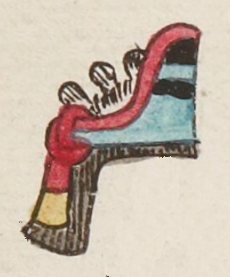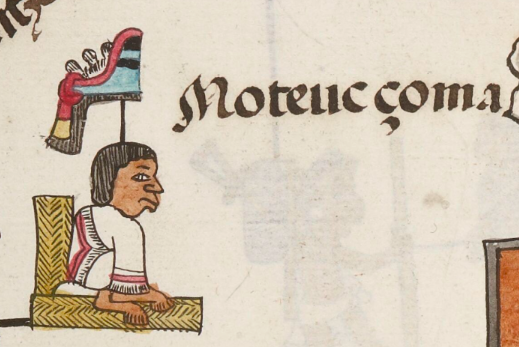Motecuhzoma Ilhuicamina (TR41r)
This colorful compound glyph for the personal name Motecuhzoma (the name of two famous Mexica rulers) shows a turquoise blue, black, red, and yellow diadem (a semantic indicator for tecuhtli, also spelled teuctli, meaning lord), and so providing the phonetic part of the name that is -tecuh-). The crown-like headgear is shown in profile, facing toward the viewer's right. Some feathers (ihuitl) are just visible above the red trim. Perhaps these are a near homophonic indicator for Ilhuicamina ("He Who Shoots Arrows at the Sky"), the elder Motecuhzoma, a mid-fifteenth century ruler. The black details consist of two horizontal stripes near the top of the diadem. The red trim is what comes to be tied in the back. Hair (tzontli) shows below the diadem, providing the phonetic indicator for the final part of the name (-zoma).
Stephanie Wood
Marc Thouvenot's project, Vignettes, includes an image about this Moteuczoma from the Códice Matritense de la Real Academia: https://vignettes.sup-infor.com/imagen/5-RA_01_051r_e. The hieroglyph is worth comparing.
Stephanie Wood
Moteucçoma
Motecuhzoma
Stephanie Wood
ca. 1550–1563
Jeff Haskett-Wood
crowns, diadems, diademas, tied, atado, hair, cabello, pelo, nombres de hombres, personas famosas, feathers, plumas

tecuh(tli), lord, https://nahuatl.wired-humanities.org/content/tecuhtli
Motecuhzoma, name of a Mexican ruler, https://nahuatl.wired-humanities.org/content/motecuhzoma
zoma, to frown in anger, https://nahuatl.wired-humanities.org/content/zoma
zomal(li), anger, https://nahuatl.wired-humanities.org/content/zomalli
tzon(tli), head-hair, https://nahuatl.wired-humanities.org/content/tzontli
ilhuica(tl), the sky, heavens, celestial realm, https://nahuatl.wired-humanities.org/content/ilhuicatl
ihui(tl), feathers, https://nahuatl.wired-humanities.org/content/ihuitl
Su Feroz Señor
Stephanie Wood
Telleriano-Remensis Codex, folio 41 recto, MS Mexicain 385, Gallica digital collection, https://gallica.bnf.fr/ark:/12148/btv1b8458267s/f107.item.zoom
The non-commercial reuse of images from the Bibliothèque nationale de France is free as long as the user is in compliance with the legislation in force and provides the citation: “Source gallica.bnf.fr / Bibliothèque nationale de France” or “Source gallica.bnf.fr / BnF.”










